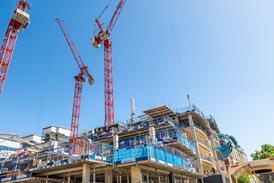Sustainability is the subject of the first survey of the Regenerate Leaders, our think-tank of regeneration’s top executives. What emerges is that the industry is eager to act, but desperate for a clearer lead from government on the most joined-up, sensible and effective way to do so.
Should we be importing wood pellets for biomass boilers in housing developments from Scandinavia or building nuclear power stations? Should we focus on making new homes zero carbon, or ensure that the environmental performance of existing housing is improved?
These are seriously big questions for the UK, and ones that are too big for the regeneration sector alone to resolve. And yet the industry is tasked with the challenge of delivering sustainable regeneration in towns and cities across the country on a daily basis.
Sustainability is therefore a natural subject for the first survey of the Regenerate Leaders, our think-tank of top executives within regeneration. The Regenerate Leaders are all firmly engaged in the government agenda to deliver sustainable physical regeneration, as senior players in local authorities, delivery agencies, housebuilders, developers and housing associations. Their answers to our survey reveal that the industry’s most senior figures are eager to act on sustainability, but desperate for a clearer lead from government on the most joined-up, sensible and effective way to respond.
Our first question to the leaders was: do you feel that there is enough common understanding of what sustainable regeneration – and specifically targets such as zero carbon – means? Every single respondent answered with an unambiguous no. Many respondents spoke of a need for clarity in the face of confused messages, jargon and sound bites.
There are 1,200km of sea defences, and rising sea levels leave the South-east region facing difficult decisions as to whether to maintain, improve or even abandon some of these defences.
Pam Alexander, SEEDA
Several respondents drew attention to the competing agendas surrounding the many and varied issues that come under the catch-all term of sustainability. There were concerns about government inconsistency and a lack of joined-up thinking, not least because these issues come under the remit of four different government departments.
When asked about the rapid pace of government policymaking, our leaders were fairly evenly divided on whether it was too fast, too slow or just right. It might be expected that the split might reflect a consensus of view from private sector and public sector think-tank representatives, but in fact that was not the case.
Those who considered it too fast were concerned that the government’s present course could not allow enough time for trialling and testing technology. A key area where some leaders felt that policy was moving too slowly was on existing housing stock, where zero carbon strictures do not apply. David Cowans, chief executive of Places for People, issued a call for action: “A coherent strategy and action plan for delivering 60% carbon emission savings across the whole housing sector by 2050 is urgently needed. This must include firm targets for the number of households to be transformed each year, and scale of energy savings to be delivered.”
The approach of stringent environmental standards for new homes, in the form of the Code for Sustainable Homes, has the potential to drive massive demand for environmental technology and is spawning a new breed of sustainability advisers and consultants. The majority of our leaders believe that there are not enough knowledgeable and experienced consultants, suppliers and manufacturers operating in the UK to help deliver sustainable regeneration at the right price. Some respondents remarked wryly that there were plenty of consultants in the sector, but that not all of them were highly expert in the field. All recognised that sustainability is an evolving sector, with a relatively new and immature market, and that there is a need to work with the supply chain and improve market demand.
Creating sustainable places involves dealing with more than just social, economic and environmental issues. We are working to create places that are culturally as well as ecologically sustainable.
Max Steinberg, Elevate
Our final question to our industry experts was an open one: what is the biggest sustainability/environmental challenge that your organisation faces in delivering physical regeneration at this time? The responses were wide-ranging. Some highlighted the bureaucracy and legislation surrounding delivery, others raised concerns about the risks of being pressed into using potentially untested environmental technology. A commonly voiced challenge was zero carbon/the Code for Sustainable Homes, and specifically the need to balance that with the costs of developing environmentally friendly homes and deliver all other aspects of sustainability.
Terms such as “balance” and “conflicting demands” came up again and again in the Leaders’ responses. As Alan Cherry, chairman of Countryside Properties, put it: “You can embrace just part of the sustainability agenda and do it well, but if you don’t engage with all the issues, then it’s not a truly sustainable solution.
“All the issues are important – it is a question of balance that must be understood and appreciated. Zero carbon should be balanced with mixed-tenure homes, adequate social and community facilities, sustainable infrastructure and greater use of public transport. Bringing all these things together is the biggest challenge.” And at the moment, it is one on which the government appears to be offering inadequate guidance.
The view from: Pam Alexander chief executive of SEEDA

A climate study by the Organisation for Economic Cooperation and Development has maintained that the South-east of England could eventually be as dry as the Sahara. Yet much wetter winters also have serious implications for flooding. The South-east region has more than 3,000km of main river flood defences, and some rivers have extensive floodplains. There are also 1,200km of sea defences, and rising sea levels leave the region facing difficult decisions as to whether to maintain, improve or even abandon some of these defences.
The weather last summer provided a hint to us all of the economic challenges to business and the scale of potential adaptation needed to the region’s infrastructure in order to handle climate change. Managing the region’s water resources is certainly one of the biggest environmental challenges we face, and changing requirements are a real problem for delivering schemes.
With this in mind, the South East England Development Agency is encouraging the design of developments which are carbon neutral and contain benefits for flood protection. For example, in the Thames Gateway we are working with the DCLG, the East of England Development Agency and the London Development Agency to make space for variable water movements in a number of locations in the Thames Estuary functional flood plain. An extra 0.71 metres of flood protection should represent a 70-year buffer against probable sea level rises.
The view from: David Cowans group chief executive, Places for People
 We have invested heavily in existing communities but we want to do far more. The technological and knowledge challenges are big enough, yet the one question few are discussing is who pays. Zero Carbon Homes will not come at zero cost. The race to be carbon neutral will lead to higher costs and will impact on margins, house prices and land values.
We have invested heavily in existing communities but we want to do far more. The technological and knowledge challenges are big enough, yet the one question few are discussing is who pays. Zero Carbon Homes will not come at zero cost. The race to be carbon neutral will lead to higher costs and will impact on margins, house prices and land values.
The industry’s aim for the next 10 years must be creating a new model for housing – technical and financial. Creating this will deliver the prize of creating sustainable communities. No-one knows all the answers but unless you are out there working on this, you will be left behind.
The view from: Max Steinberg chief executive of Elevate East Lancashire
 Elevate’s approach to regenerating Pennine Lancashire’s inner urban neighbourhoods is a comprehensive one. Our aim is to build long-term sustainable communities by improving quality and choice in the housing market and by promoting effective neighbourhood management.
Elevate’s approach to regenerating Pennine Lancashire’s inner urban neighbourhoods is a comprehensive one. Our aim is to build long-term sustainable communities by improving quality and choice in the housing market and by promoting effective neighbourhood management.
Creating sustainable places involves dealing with more than just social, economic and environmental issues. We are working to create places that are culturally as well as ecologically sustainable – places that celebrate and reinforce local distinctiveness.
Pennine Lancashire suffers from acute economic deprivation. Through working with our partners, we are influencing improvements to employment provision and accessibility to jobs to make our places more sustainable. We have recently appointed a creative community engagement manager to foster new approaches to community involvement in placemaking. We work very closely with Cabe to ensure that we follow best practice in relation to masterplanning and design development.
Elevate has a series of KPIs which our lead development partners are obliged to adhere to. These include EcoHomes – Very Good. Our Constructing The Future team works with local businesses to encourage growth in sustainable design and manufacturing. We are undertaking research to better understand how the existing housing stock can be refurbished to reduce carbon emissions. We are working on how to embed sustainable design principles at all stages in the development – for example, looking strategically at neighbourhood layouts, orientation and movement patterns.
We think this comprehensive approach to regeneration will leave behind a legacy of Pennine Lancashire communities which are sustainable, with a housing market no longer requiring public investment.
Source
RegenerateLive
























No comments yet